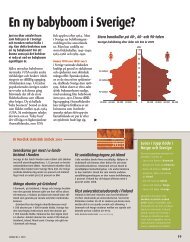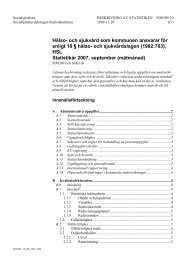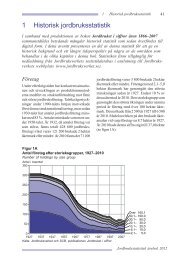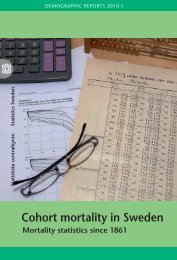Perspektiv på välfärden 2004 (pdf) - Statistiska centralbyrån
Perspektiv på välfärden 2004 (pdf) - Statistiska centralbyrån
Perspektiv på välfärden 2004 (pdf) - Statistiska centralbyrån
You also want an ePaper? Increase the reach of your titles
YUMPU automatically turns print PDFs into web optimized ePapers that Google loves.
It is important to stress the gender difference.<br />
Women had lower incomes in youth and they<br />
were more deprived. This situation was not counterbalanced<br />
by the development over time, but<br />
was, on the contrary, exaggerated, with both income<br />
and deprivation developing less favourably<br />
for women as compared to men. The gender differences<br />
were not an effect of women’s educational<br />
choices (no difference between the sexes is<br />
observed), neither were they caused by other circumstances<br />
controlled for in the model (unemployment,<br />
nest leaving, parenthood, social assistance).<br />
It was rather the case that the indirect effects<br />
offset the direct gender effect. Thus, women<br />
face a more difficult economic situation during<br />
youth, mainly because they are women and partly<br />
because they, as such, are more exposed to situations<br />
that detrimentally affect their economic<br />
situation. However, women’s unfavourable development<br />
over time is not explained by these ‘situations’<br />
in youth; the explanation should rather be<br />
sought in the gendered structure of society – a<br />
structure that systematically influences labour<br />
market careers and family obligations during<br />
youth as well as adulthood.<br />
The other variables measuring the situation<br />
during youth had less clear-cut impacts. Young<br />
people that studied had, as expected, low incomes<br />
and the longer they studied the more economically<br />
deprived they tended to be. Yet in a longer<br />
perspective, the investments in human capital<br />
resulted in a more rapid income increase and a<br />
decrease in economic difficulties. Long-term unemployment<br />
in youth was associated with low<br />
income and a high incidence of economic<br />
deprivation during youth, but the long-term<br />
impact was small. Youth unemployment was not<br />
associated with an ongoing economic marginalization<br />
process. However, there were no signs that<br />
the (long-term) unemployed would make up for<br />
their unfavourable starting position later on in life.<br />
Thus, the economic losses induced by<br />
unemployment in youth are in most cases not<br />
regained in adulthood. The result also confirms<br />
that a shorter period of unemployment during<br />
youth is a quite unproblematic phenomenon.<br />
The negative effect in youth of nest leaving<br />
was more or less counterbalanced during adulthood<br />
by a relatively positive income development<br />
and negative growth in economic deprivation.<br />
Also early parenthood was related to economic<br />
problems in youth, but in this case future development<br />
was not very positive and there seems to<br />
be a longstanding impact on the incidence of economic<br />
deprivation. Recipients of social assistance<br />
reported a much higher incidence of deprivation<br />
than did any other group. It is important to note,<br />
however, that the development over time was not<br />
terribly poor and that this group showed the great-<br />
Youth<br />
est decrease in deprivation. Hence, it could not be<br />
shown that recipients of assistance were "losers"<br />
in the long run.<br />
The main conclusions to be drawn are the following:<br />
• Young people’s incomes do not say very much<br />
about their current standard of living or future<br />
earning ability. If anything, low income is a<br />
predictor of substantial future income growth.<br />
There are good reasons to be sceptical regarding<br />
the importance of analysing young people's income<br />
situation and the incidence of income<br />
poverty among the young.<br />
• Being economically deprived during youth is<br />
unrelated to the development of deprivation<br />
over time. Hence, the finding that young people<br />
in general face economic difficulties does not<br />
imply that we are observing a problem with<br />
lasting implications.<br />
• Labour market situation and household characteristics<br />
during youth are only modestly related<br />
to the development later on in life. However,<br />
long-term unemployment hampers young people's<br />
economy, and there is nothing in this study<br />
to indicate that this situation will be counterbal-<br />
anced over time.<br />
Most importantly, the results of this analysis emphasize<br />
the importance of the reproduction of<br />
class and gender relations. It is these two fundamental<br />
aspects that more than anything else affect<br />
young people, on their way into adulthood and in<br />
their future life as adults. So, back to basics –<br />
fight class differences and promote gender equality.<br />
77

















